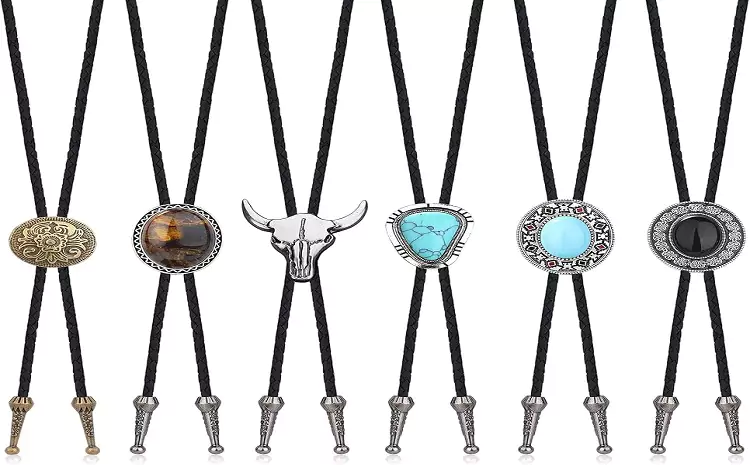The bolo tie is a unique fashion accessory with deep cultural significance. Originating from the Southwest Indigenous people, bolo ties are strongly associated with Hopi, Navajo, Zuni, and Puebloan silversmithing traditions. As bolo ties become more popular in mainstream fashion, questions about cultural appropriation arise. This article will explore whether wearing a bolo tie is considered cultural appropriation, and how to wear it respectfully while honoring its roots.
Key Takeaways
- Bolo ties are rooted in Southwest Indigenous culture and have significant historical and cultural value.
- Using a bolo tie without understanding its meaning can lead to accusations of cultural appropriation.
- Wearing bolo ties with respect for their cultural origins can be an act of appreciation, not appropriation.
What is a Bolo Tie?
A bolo tie (also known as a necktie or simply a bolo) is a type of neckwear consisting of a cord with a decorative clasp, often made of silver, turquoise, or other precious materials. It is traditionally worn by Hopi, Navajo, Zuni, and Puebloan people in the Southwest United States. Over time, bolo ties have gained popularity beyond Indigenous communities, becoming a symbol of Western fashion.
Origin and Cultural Significance
Bolo ties are more than just accessories. They are a part of the Southwest Indigenous culture and reflect the craftsmanship of silversmiths and artisans. The designs often incorporate traditional motifs and symbols, making each tie a piece of art.
| Aspect | Details |
|---|---|
| Origin | Southwest Indigenous tribes |
| Materials Used | Silver, turquoise, gemstones |
| Craftsmanship | Reflects Navajo, Hopi, Zuni, and Puebloan silversmithing traditions |
| Symbolism | Represents cultural heritage and identity |
Is Wearing a Bolo Tie Cultural Appropriation?
Cultural appropriation occurs when elements of one culture are used by another culture, often without permission, and in a way that disrespects or diminishes the original significance. When it comes to bolo ties, this can happen if the wearer has no understanding of the item’s cultural context or uses it in a way that is disrespectful to its origins.
When Does Wearing a Bolo Tie Become Cultural Appropriation?
Using a bolo tie can be considered cultural appropriation if:
- No Understanding of Its Origin: The wearer is unaware of the tie’s cultural roots and symbolism.
- Misrepresentation: The bolo tie is worn in a manner that misrepresents or mocks its cultural significance.
- Ignoring Craftsmanship: Mass-produced bolos that disregard traditional craftsmanship can be seen as appropriative.
When is Wearing a Bolo Tie Not Cultural Appropriation?
However, wearing a bolo tie is not cultural appropriation if:
- Cultural Appreciation: The wearer understands the history and cultural background of the bolo tie and acknowledges its origins.
- Supporting Indigenous Artists: Purchasing bolo ties from Indigenous artisans shows respect and supports the community.
- Appropriate Context: The bolo tie is worn in settings that respect its traditional use, such as formal occasions or cultural events.
| Appropriation | Appreciation |
|---|---|
| Wearing bolo ties without context | Understanding and respecting its cultural significance |
| Using mass-produced bolos | Purchasing from Indigenous artists |
| Wearing it mockingly | Wearing it with dignity in appropriate settings |
How to Wear a Bolo Tie Respectfully?
Learn About Its Cultural Background
Before wearing a bolo tie, take the time to learn about its cultural history. Understand the craftsmanship of Hopi, Navajo, Zuni, and Puebloan traditions and the significance of the materials used.
Buy From Indigenous Artisans
Support Indigenous artists by purchasing bolo ties made by them. This not only respects their craft but also helps preserve traditional techniques.
Wear It in the Right Context
Bolo ties can be appropriate for more formal occasions or events celebrating Western or Indigenous culture. Avoid wearing them in casual or irreverent contexts where their significance might be diminished.
Why Cultural Appropriation Matters?
Cultural appropriation is harmful because it can reduce meaningful cultural symbols to mere fashion trends, stripping away their significance. When bolo ties are used without acknowledging their origins, it disrespects the rich history and contributions of the Southwest Indigenous people.
Cultural Appropriation vs. Cultural Appreciation
The line between cultural appropriation and appreciation can be thin. Here’s a quick comparison:
| Cultural Appropriation | Cultural Appreciation |
|---|---|
| Using without understanding | Educating oneself about the cultural background |
| Ignoring the origins and meaning | Acknowledging and honoring the history and significance |
| Disrespectful usage | Using in ways that elevate and celebrate the culture |
Final Thoughts
Understanding the cultural significance of bolo ties is essential to avoid cultural appropriation. By recognizing the artistry and heritage behind these items, you are not only respecting the culture but also supporting the communities that create them.

